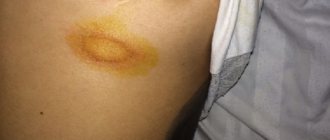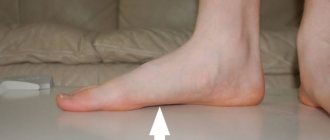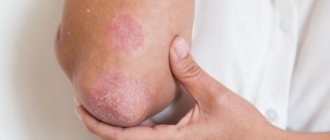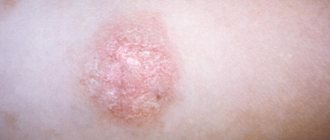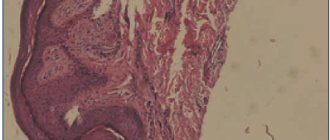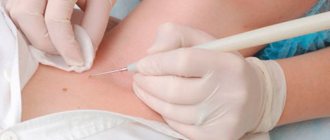What is solar lichen?
Sun lichen is more of a “beach disease” and is seasonal.
Outbreaks often occur in people:
- during the heat;
- if personal hygiene is not properly observed.
The course of the disease is asymptomatic due to the long incubation period of lichen.
A person begins to pay attention only when pain and unpleasant symptoms appear:
- darkening of the spot;
- increase in size;
- spread throughout the body;
- covering with scales;
- the appearance of itching and burning on the body when a bacterial infection is attached;
- peeling when scratching.
In the article on the topic of spots on the body similar to lichen, you can read about other types of this skin disease.
Features in children
The manifestation of the disease in children is almost entirely similar to the symptoms in adults.
In children, spots most often form on the arms, legs, head and armpits. It is better to treat children's beach lichen only by a dermatologist and avoid using traditional methods, since a child's skin is more delicate and requires a special approach.
Children with reduced immunity are more often exposed to sun fungus, so it is worth paying attention to increasing the child’s body’s defense mechanisms.
Causes of solar lichen
The main factors for the occurrence of lichen:
- prolonged exposure to the sun;
- fungal growth under the skin;
- violation of acid-base balance;
- failure in the endocrine system;
- excessive sweating of the body due to hyperhidrosis, overweight, obesity;
- diabetes;
- weakened immune system;
- deviation from the normal pH level on the skin due to frequent use of antibacterial care products
In addition, this may be a consequence of:
- hormonal imbalance;
- pathologies in the liver or kidneys;
- suppression of skin immunity;
- frequent use of cosmetics;
- tanning abuse;
- diseases of the biliary tract;
- malfunctions in the functioning of internal organs;
- activation of fungus under the skin;
- microbial damage to large parts of the epidermis, with the appearance of dark brown or beige spots;
- development of inflammatory processes caused by pathogenic bacteria;
- exposure to ultraviolet rays on the décolleté, arms, forearms, shoulders, back.
What does solar lichen look like?
Against the background of hyperhidrosis and a malfunction of the immune system, it is not at all difficult to recognize solar lichen.
It usually appears on the body in the form of:
- pink, yellow-brown spot like lichen versicolor affecting the back, neck, limbs, shoulders, chest, or other open area of the body;
- a beige spot with fuzzy edges, accompanied by itching and burning when a bacterial infection is attached.
The patient can see a luminous spot that has no special symptoms, almost merging in color with the skin. Gradually covered with scales, has asymmetrical torn edges. The spots are localized on the neck, shoulders, abdomen, and limbs. The color can vary: from dark burgundy to coffee-milk.
Photo
On the website you can read in detail about other types of disease and see photos of lichen in humans.
Diagnostics
At the first signs of any pathological changes in the skin, you should consult a specialist. The dermatologist will conduct a visual examination and, based on the test results, make a diagnosis. Only after this the specialist prescribes how to treat solar lichen. In order to accurately determine the nature and nature of the pathological process, the doctor may recommend undergoing the following series of examinations:
- Balzer test. A small amount of iodine is applied to an area of skin, and in cases of lichen damage, it turns an intense brown color;
- Test for Beignet's sign. It is carried out by scraping the top layer of the epidermis;
- Diagnostics using a fluorescent lamp. The light flux is directed to the pigment spot, and the focus of the pathology is painted in dark brown, green or red tones.
All these studies are carried out against the background of a comparative analysis of the results obtained with the symptoms of diseases such as leukodermatitis, syphilitic roseola, leprosy and Giber's disease. If a specialist excludes all of the listed diseases, he will immediately prescribe a regimen and tell you how to treat solar lichen.
Stages of development of solar lichen
If left untreated, the disease will begin to progress rapidly, leading to complications and a chronic course.
Solar lichen has three stages of development:
- At the first stage, a pink spot up to 2.5 cm in diameter of different colors appears, similar in characteristics to lichen versicolor.
- At the second stage , the spot darkens, acquires a brown tint, increases in size, or several spots appear at once, merging with each other, forming a rather large lesion on the body.
- At the third stage , the spot grows, begins to itch, and peels off, with the crust coming off when scratched. The spot is similar to pityriasis versicolor on the body.
Complications
When asked why solar lichen is dangerous, many dermatologists answer that the disease is only a cosmetic defect. There is also a small danger of infecting people with whom the patient is in close contact (especially if they often suffer from colds or have other pathologies that reduce immunity).
Some experts note that if solar lichen is not treated, more serious consequences may develop in areas where the fungus has spread: areas of suppuration, weeping eczema. The resulting itching and desire to get rid of stains lead to neuroses.
Symptoms of solar lichen
Symptoms appear suddenly: after another tan, a person discovers a dark spot on the skin. Thanks to the signs of the disease, you can answer the question of how to identify lichen.
Primary signs include:
- the appearance of a ragged spot, slightly different in color from healthy skin;
- gradual increase in size;
- merging of several spots at once into one large formation, leading to discoloration of the area;
- spread of lichen over large areas;
- peeling and itching of the spot;
- coloring from pink to brown.
Closer to winter, the spot may disappear, but when sunny days appear or after visiting a solarium, it may appear again. It happens that it occurs with increased sweating and begins to itch severely, causing both cosmetic and psychological discomfort.
Varieties and atypical forms
Beach sickness manifests itself in the form of discolored areas of skin against the background of a general tan. The spots can be of varying sizes, from a few millimeters to several centimeters.
In rare cases, the disease may begin to manifest itself during the cold season. Slightly pink spots with shiny edges appear on the skin; after receiving the first tan, they become lighter against the background of the entire skin.
Location of beach lichen:
- back,
- neck,
- breast,
- stomach.
In rare cases, atypical places of formation include the head, the occipital part, and sometimes the lower extremities. If left untreated, the spots may change color from white to dark brown, and mild itching may occur, but this is more an exception than a typical manifestation of beach fungus.
Treatment
Solar lichen is a disease of young people and the likelihood of relapse is high. When a dubious spot appears on the body, it is extremely important to identify the cause and consult a dermatologist.
You might be interested! Types of skin lichen in humans and methods of its treatment
Treatment is complex and long-term with the prescription of medications, antifungal ointments, creams, and gels. Doctors do not advise self-medication. Relapses are possible when affected by a fungus, or the addition of secondary infections against the background of a malfunction in the immune system.
The treatment plan is approximately as follows:
- Rinse the affected areas with anti-dandruff shampoo (Sebozol, Dermazol, Nizoral).
- Lubricating problem areas with antifungal ointments (Miramistin, Terbinafine, Cyclopiroxolamine, sulfuric acid, salicylic acid, iodine, apple cider vinegar, salicylic alcohol 5%) every 3-4 hours.
- Taking multivitamins to strengthen the immune system
- Taking treatment with antifungal drugs in tablets for a comprehensive effect on lichen in combination with ointments, shampoos, and folk remedies. Antifungal drugs are also used in the treatment of lichen on the head of a child.
Types of treatment:
- Systemic treatment consists of taking medications to avoid relapses (Orungal, Itraconazole, Ketoconazole), also vitamins, immunomodulatory drugs.
- Local or external treatment with salicylic, sulfur ointment, resorcinol, salicylic alcohol, Cyclopirox, Lamisil, Mycozolon. First you need to wash your head or other problem areas with a special shampoo, only then apply an even layer of salicylic, resorcinol or other ointments.
Treatment of sun lichen at home
At home, you can get rid of unpleasant symptoms on your body:
- sea buckthorn and rosehip oil for excessive skin sensitivity by rubbing into affected areas;
- olive and sunflower oil for treating areas of depigmentation;
- apple cider vinegar you can make at home
- tincture of calendula (flowers). To do this: pour pure alcohol (1x5), leave for 1 week in a dark place, wipe the areas 2-3 times a day;
- sorrel to restore the acid-base balance in the layers of the epidermis. It is useful to simply eat it, add it to salads, or squeeze the juice and prepare a cream with the addition of low-fat sour cream. Apply as a compress to the affected area until improvement occurs.
Folk remedies
Traditional healers recommend lubricating the affected areas:
- warm solution of boric acid containing 1 tsp. for 1 glass of water;
- apple cider vinegar by rubbing into the skin;
- rosehip oil, sea buckthorn;
- onion juice.
In addition, there are the following recipes:
- You can take honey mixed with baking soda (1x1), sip apple cider vinegar 2-3 times a day.
- Prepare sorrel infusion. Grind the root and leaves, add sour cream. Rub into the affected areas 2 times a day or wipe with a solution of boric acid by diluting with water.
Folk remedies will not be able to completely get rid of sun lichen, but they can completely stop the disease and minimize its manifestations. The insidiousness of solar lichen is that the spot may appear again with the arrival of the hot summer season or autumn.
People with fair skin that is rather unstable to sunlight and tanning should beware of the following effects on the skin:
- avoid visiting the solarium;
- wear clothes only from natural materials;
- do not neglect observing basic rules of personal hygiene.
Folk remedies
In some situations, you can prepare special medicines to get rid of skin fungus using the following recipes at home:
- Sea buckthorn oil. Treat affected skin with undiluted product 2 times a day. You can add a few drops of healing oil to any nourishing cream and lubricate lichen spots. Sea buckthorn oil has a healing, soothing effect;
- Rosehip infusion. An excellent remedy that strengthens the immune system. Pour 2 tbsp into a thermos. l. fruits, pour in 0.5 liters of boiling water. After two hours, strain the infusion. Take half a glass orally twice a day. Some herbalists recommend treating spots with “sun fungus” with infusion; wild or horse sorrel. Finely chop a bunch of leaves and combine with a tablespoon of sour cream. Apply the paste onto the stains and wash off after 15 minutes;
- Apple vinegar. Only a high-quality product is suitable for treating lichen spots. Every three hours, wipe away any blemishes on your body with apple cider vinegar. Watch the reaction. If itching or severe peeling occurs, stop the procedure;
- Rosehip oil. Buy healing oil at the pharmacy. Apply to affected areas twice daily.
Despite the fact that a disease such as solar lichen does not cause serious consequences for the patient himself and is not dangerous for others, it must be treated immediately after detection. Otherwise, it will spread very quickly throughout the body and become a real disaster, especially for women. Widespread lichen can be extremely difficult to get rid of, so try not to let the situation get worse.
Prevention
According to doctors, solar lichen on the skin appears only when favorable conditions and factors provocateurs for its development appear. The disease is difficult to treat, and it is impossible to completely protect the skin from a new outbreak. As soon as it gets hot outside, after even a short stay in the sun, a spot may suddenly appear on the skin.
Methods for preventing sun lichen:
- It is important to avoid exposure to the sun's rays on the body, wear closed clothes, and do not visit a hot steam room or solarium.
- If you had to sunbathe on the beach and swim in the sea, then immediately after leaving the water, wipe your body dry, without leaving it wet. The tan sticks well to a wet, damp body.
- Treat exposed areas with sunscreen.
- When sunbathing on the sand, it is better to lay down a bedding and not lie down with your naked body in the hot sand.
- Use personal towels on the beach.
- After visiting the beach, come home and rinse with plain water.
- Do not use other people's things, remembering that lichen is contagious.
- Try to wear only natural, breathable clothes.
- Shower more often on hot days.
- Do not refuse to take vitamins and restoratives.
All girls want to have a beautiful chocolate tan on their body. But safety comes first. Such unpleasant manifestations as pityriasis versicolor or solar lichen are completely unsightly on the body. Getting rid of them is quite problematic, and self-treatment can only worsen the situation.
If the disease cannot be avoided, then it is worth visiting an experienced dermatologist , listen to all his advice and recommendations, and strictly adhere to the prescribed treatment and preventive measures.
Reasons for development
Dermatologists agree that the stratum corneum of the epidermis and hair cuticles are affected due to the action of fungal microorganisms from the genus Pityrosporum and Malassezia. They are transmitted only through long-term and close contact between a sick person and a healthy person. Solar lichen is usually considered to be less contagious.
The likelihood of infection is largely determined not by contact with infected people, but by the general condition of the body. It may take several weeks from the moment of infection to the appearance of the first symptoms. If conditions are favorable for them, mushrooms begin to actively reproduce.
Provoking factors due to which infection may occur are as follows:
- Weak protective resources of the body;
- Obesity;
- Frequent colds;
- Uncontrolled use of antibacterial agents;
- Wearing synthetic clothing for a long time;
- The use of antibacterial gels that affect the composition of microflora and reduce the protective properties of the skin;
- Excessive exposure to ultraviolet rays during long-term and frequent stays on the beach or regular visits to the solarium. Hence the name “sun fungus” or “beach disease”;
- Excessive use of tanning products, which can provoke allergies and fungal growth.
Some dermatologists are inclined to believe that people with pulmonary tuberculosis and lymphogranulomatosis are more susceptible to solar lichen.
